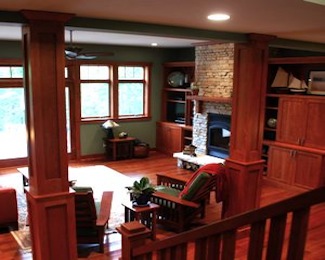Green Building Blocks: The Foundation
Building or renovating a home to be energy-efficient using renewable, recycled, or otherwise sustainable methods and products is a process involving many, many decisions. In a perfect world, we would be able to integrate green products and materials into every single part of the home to create a 100% green home. Unfortunately, reality can sometimes throw a wrench into those plans, typically in the form of budget constraints.
It's understandable that homeowners want to incorporate as many green ideas into their home as possible, but when it's not possible to do everything at once (which is usually the way it is), our Building Blocks approach to planning and design can help identify areas to focus on first.
Build a Green Foundation
The Building Blocks identify the different aspects of green design and construction, then categorize them by how difficult they are to implement, how expensive they are up-front, how much energy or other resources they save, and finally, how long the investment payback period is.The foundation blocks are those that should be considered before others; they're the easiest to implement, have the quickest payback period, and typically are less expensive. For those on a budget, they give any home a great start at being green, even if nothing else is done with the home.
Location, Location, Location
The physical location of a home can be a green asset. A home built far from town or city centers requires an automobile to do just about anything. Getting to work, school, shopping, even the kids' friends: they all require a car ride.Building the home closer to these things greatly reduces automobile usage. Not only does this reduce gas usage and the pollution issues associated with it, it saves a great deal of money. Proper site location allows for the use of public transportation, bicycles, even walking to where you need to go. When the car is used, it's for much shorter trips.
Home Siting
How a home is situated on its property affects its' "greenness". A well-designed site plan takes advantage of free solar light and energy, which will reduce the use of fossil fuels in lighting and heating the home. A green site plan will also take great care to reduce or eliminate damage to the existing plants and trees on the site.
For further reading on green home siting, click here.
Home Size
The physical size of a home affects the size of its environmental footprint. It's not hard to see why; the bigger the house, the more energy it takes to heat, cool, and light it. Larger homes also require much more materials (wood, cement, glass, etc.) than a smaller-scaled structure.Doubling the size of a home can triple its annual energy use, every single year, for the life of the structure. Creative design can shrink the size of a home without affecting its livability. By eliminating little-used space and using existing space in a clever, efficient manner, a small house will still provide plenty of room to live comfortably.
Read more about the benefits of small home design here.
Education
Perhaps the most important step you can take when thinking about building green is to learn about the green home movement. By learning about the basic principles of green design and construction, you'll avoid making regretful decisions. Education is one of the main reasons for the existence of Green Home Source; our site is dedicated to helping you learn about some of these areas in easy-to-understand terms. There are also many other resources available for green education; avoiding common mistakes can save you time, money, and lots of energy down the road.
Click HERE to return to the main Building Blocks of Green page.
comments powered by Disqus



























































































































































































